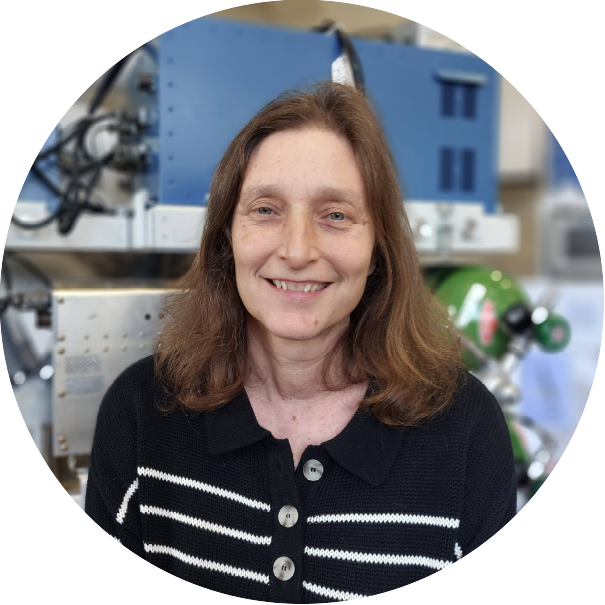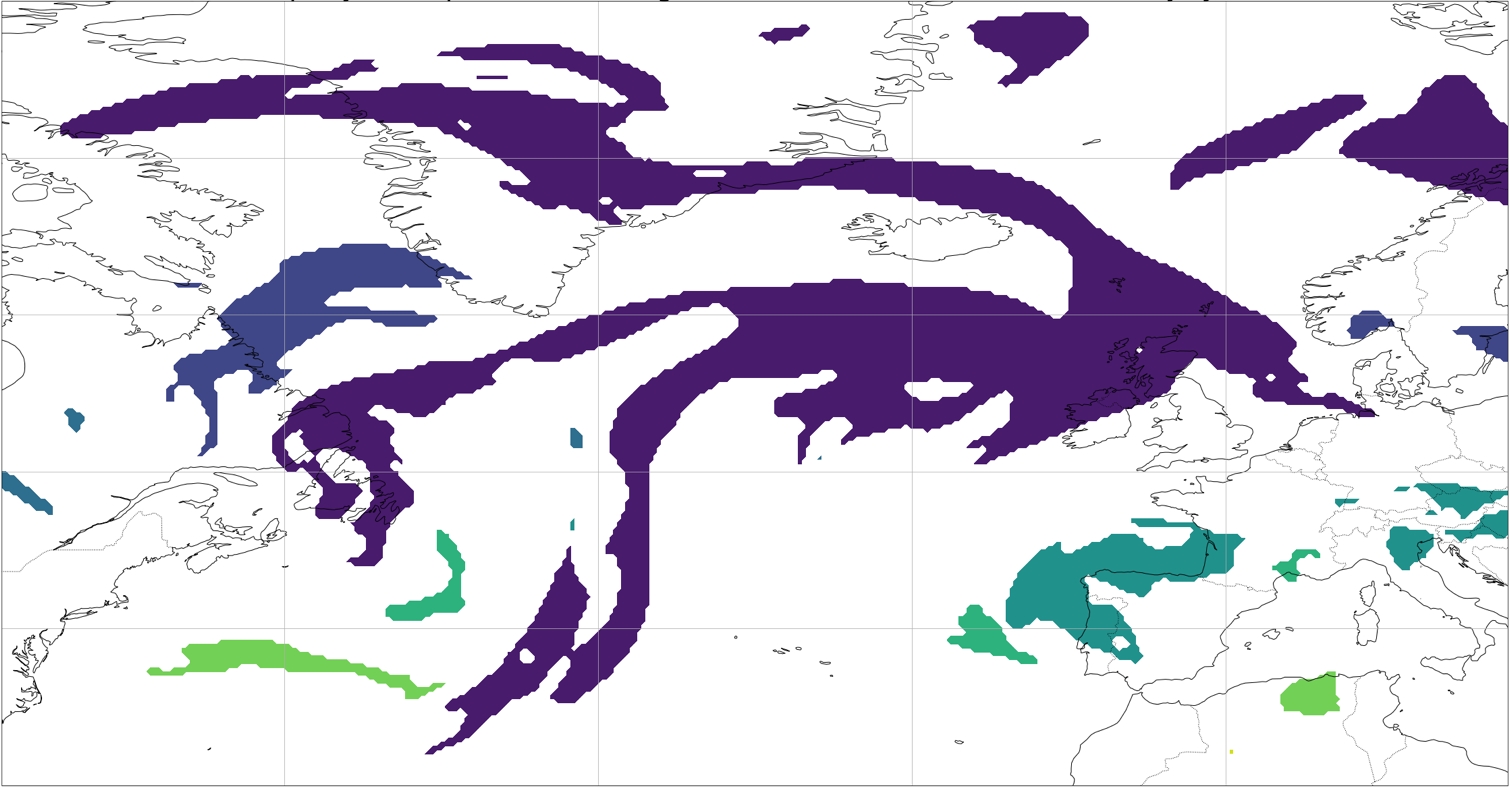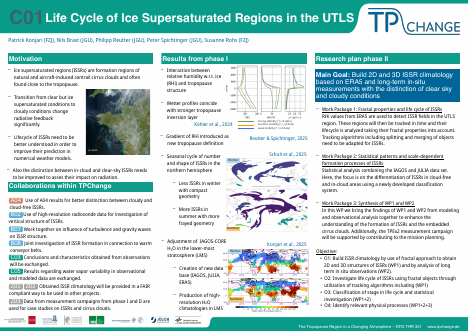
Project C01:
Life Cycle of Ice Supersaturated Regions in the UTLS
Brief Summary
High in the upper troposphere and lower stratosphere (UTLS), air temperatures are extremely low, and water vapour concentrations are small. Under these conditions, the air is usually subsaturated with respect to ice, meaning that ice crystals would sublimate. However, regions where the relative humidity with respect to ice (RHi) exceeds 100% while no cloud particles are yet present are common. These regions are called ice-supersaturated regions (ISSRs). They are crucial for understanding how natural ice clouds (cirrus) and aircraft contrails form and evolve. Since contrails can persist and spread into cirrus-like clouds that trap heat in the atmosphere, identifying and avoiding ISSRs is an important step toward reducing aviation’s climate impact.
In this project, we study the life cycle of ISSRs – how they form, grow, split, merge, and eventually dissipate. Using the ERA5 reanalysis, a comprehensive global dataset of atmospheric conditions, we investigate the three-dimensional geometry and evolution of ISSRs. We develop new algorithms that can track these complex structures over time and identify characteristic patterns and transitions.
To connect model-based results with reality, we compare our findings with aircraft and campaign measurements, such as those from IAGOS (In-service Aircraft for a Global Observing System) and TPEx (TPChange Experiment). This allows us to separate cloud-free from in-cloud ISSRs and better understand how these regions transform into natural cirrus clouds.
By combining physical understanding with modern machine learning methods, we aim to uncover the mechanisms that control the formation and decay of ISSRs and to describe their statistical properties on global and regional scales. The results will contribute to a more realistic representation of ISSRs in weather and climate models and help improve forecasts of upper-tropospheric humidity and cloud occurrence.
Project Poster
Evaluation Poster Phase I in 2025
Members

Dr. Philipp Reutter
Principal Investigator
Johannes Gutenberg-Universität Mainz, Institut für Physik der Atmosphäre
preutter[at]uni-mainz.de

Prof. Dr. Peter Spichtinger
Principal Investigator
Johannes Gutenberg-Universität Mainz, Institut für Physik der Atmosphäre
peter.spichtinger[at]uni-mainz.de

Dr. Susanne Rohs
Principal Investigator
Institute of Climate and Energy Systems – ICE-3: Troposphäre, Forschungszentrum Jülich
s.rohs[at]fz-juelich.de
Publications
Konjari, P., C. Rolf, M. Krämer, A. Afchine, N. Spelten, I. Bartolome Garcia, A. Miltenberger, N. Emig, P. Joppe, J. Schneider, Y. Li, A. Petzold, H. Bozem, and P. Hoor (2025b): Stratospheric Hydration and Ice Microphysics of a Convective Overshoot Observed during the TPEx Campaign over Sweden. EGUsphere 2025, [Preprint], 1–27. doi: 10.5194/egusphere-2025-2847.
Konjari, P., C. Rolf, M. I. Hegglin, S. Rohs, Y. Li, A. Zahn, H. Bönisch, M. Krämer, and A. Petzold (2025a): Technical note: Water vapour climatologies in the extra-tropical upper troposphere and lower stratosphere derived from a synthesis of passenger and research aircraft measurements. Atmospheric Chemistry and Physics 25 (7), 4269–4289. doi: 10.5194/acp-25-4269-2025
Reutter, P. and P. Spichtinger (2025): The Frosty Frontier: Redefining the Tropopause as a transport barrier using the Relative Humidity over Ice. EGUsphere 2025, [Preprint], 1–17. doi: 10.5194/egusphere-2025-2474.
Köhler, D., P. Reutter, and P. Spichtinger (2024): Relative humidity over ice as a key variable for Northern Hemisphere midlatitude tropopause inversion layers. Atmospheric Chemistry and Physics 24 (17), 10055–10072. doi: 10.5194/acp-24-10055-2024.
Petzold, A., N. F. Khan, Y. Li, P. Spichtinger, S. Rohs, S. Crewell, A. Wahner, and M. Krämer (2025): Most long-lived contrails form within cirrus clouds with uncertain climate impact. Nature Communications, 16, 9695, doi: 10.1038/s41467-025-65532-2.
Rolf, C., S. Rohs, H. G. Smit, M. Krämer, Z. Bozóki, S. Hofmann, H. Franke, R. Maser, P. Hoor, and A. Petzold (2024): Evaluation of compact hygrometers for continuous airborne measurements. Meteorologische Zeitschrift 33 (1), 15–34. doi: 10.1127/metz/2023/1187.
Groß, S., T. Jurkat-Witschas, Q. Li, M. Wirth, B. Urbanek, M. Krämer, R. Weigel, and C. Voigt (2023): Investigating an indirect aviation effect on mid-latitude cirrus clouds – linking lidar-derived optical properties to in situ measurements. Atmospheric Chemistry and Physics 23 (14), 8369–8381. doi: https://doi.org/10.5194/acp-23-8369-2023.
De La Torre Castro, E., T. Jurkat-Witschas, A. Afchine, V. Grewe, V. Hahn, S. Kirschler, M. Krämer, J. Lucke, N. Spelten, H. Wernli, M. Zöger, and C. Voigt (2023): Differences in microphysical properties of cirrus at high and mid-latitudes. Atmospheric Chemistry and Physics 23 (20), 13167–13189. doi: 10.5194/acp-23-13167-2023.
Konopka, P., C. Rolf, M. von Hobe, S. M. Khaykin, B. Clouser, E. Moyer, F. Ravegnani, F. D’Amato, S. Viciani, N. Spelten, A. Afchine, M. Krämer, F. Stroh, and F. Ploeger (2023): The dehydration carousel of stratospheric water vapor in the Asian summer monsoon anticyclone. Atmospheric Chemistry and Physics 23 (20), 12935–12947. doi: https://doi.org/10.5194/acp-23-12935-2023.


